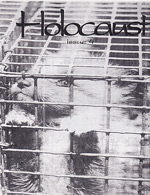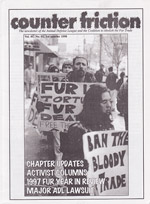The Archives
-
No Compromise, Periodicals
No Compromise #12-14
05.15.12 | PermalinkNo Compromise #12-14 (1999, Old Bridge, NJ and Santa Cruz, CA)
If I had to create a list of my favorite years in animal and earth liberation history, 1999 would be in the top 5. As the movement looked towards the new millennium there seemed to be an intense urgency in the air, perhaps people felt the need to close the 20th century with a bang or leave their mark before the world ended in a technological melt down on Y2K! Whatever the reasons, direct action reached a fever pitch. Lab raids returned to the United States, the Earth Liberation Front continued it’s ascendancy, Hillgrove farm was shut forever, and everyone seemed to be preparing for the World Trade Organization ministerial in Seattle. Across the globe there was a sense that people were not going to take it anymore, and whether you were struggling against bio-technology or prisons or speciesism, chances are good that you were employing some form of illegal tactic.
No Compromise may not have covered everything going on in the global struggle, but if it was animal lib related then chances are it was covered in these three issues. From the death of Alex Slack to end of the annual Hegins pigeon massacre, you’d be hard pressed to find a more complete overview of these twelve action packed months.
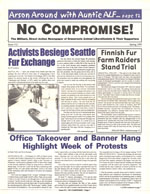
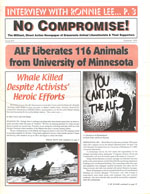
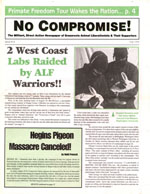
-
Site news & updates
Why You Gotta Bring Up Old Shit?
02.12.12 | PermalinkWhy You Gotta Bring Up Old Shit?
Yesterday Humane Watch, an industry AstroTurf front monitoring HSUS, posted a piece linking to our archive of Do Not Consider Yourself Free. In their typically comical fashion the group attempts to tie Pat Kwan, the Humane Society’s New York director, to “terrorism” based on his work with Animal Defense League New York and an old arrest in Massachusetts. Not mentioned in the article is the fact that Kwan was not convicted in the Mass case, that his activism with ADL NYC took place in his early teenage years, or that the change of heart he had with his later activism was criticized by the very radicals that Humane Watch attempts to tie him to. Similar obfuscations are peppered throughout the blog, but such behavior can be expected of people who publicly defend un-anesthetized castration, intensive confinement, debeaking, and other acts of brutality against non-humans.
Because this article made the rounds on social media and stirred up a fair amount of commentary the staff of TALON would like to respond to some of the points raised by our friends in the movement.
First, some readers of the article were upset that TALON makes such material available to begin with, others have asked that we remove it. For the record, TALON will never omit a piece of our movement’s history from it’s archives. The changing path taken by some activists is an important part of our struggle, and it can inform current and future tactical choices. While a person may not remain forever proud of the politics of their youth you cannot remake the past by simply erasing old articles. A better path would be to explain the reasons you altered your course, and if anything the Humane Watch article gives apologetic ex-militants the perfect opportunity to do so. Our opponents will call those explanations insincere, but they will call you whatever they are paid to regardless of the truth.
Second, a few people mocked what they saw as the “selling out” of 90s era grassroots radicals who now work for groups like PETA and HSUS. Those of us who have been around for a while have seen the departure of hundreds and hundreds of once staunchly aggressive activists who now do nothing at all for non-humans. That is selling out. Our friends who carry on the fight, even when we don’t see eye to eye on tactics, should be admired for their longevity instead of harangued for thinking differently. The staff of TALON believe that there is a need for underground, illegal strategies in furtherance of animal liberation, but we are not a cult. Our strength lies in a diversity of thought, action and scale, not in the lockstep marching of cloned henchmen. We find it regrettable that some good activists now disapprove of groups like the Animal Liberation Front, but we love our comrades regardless and recognize them as dedicated allies in this struggle.
Our cause is already weakened by deep factionalism, to let groups like Humane Watch drive further wedges between us is counter productive to the goal that we all share regardless of group affiliation or tactical preference: an end to domination of all life on earth by a single species. Reaching that goal will require a broadening of our coalitions and a minimizing of internal conflict.
…
-
Periodicals, Videos
Breaking Free Video Magazine #2
12.19.11 | PermalinkBreaking Free #2 (1999, Eugene, OR.)
The second and final episode of Breaking Free has some glaring faults: jokes that are not funny, computer animation that is antiquated and was already embarrassing upon it’s release, and no shortage of bad titling choices. It also contains footage of some of the most important and influential campaigns of the era it was produced, especially the Consort Kennels and Hillgrove protests which eventually led to the international fight against Huntingdon Life Sciences. Many long forgotten ALF raids are also shown, along with the final major civil disobedience actions at the end of the voluntary arrest era of the 1990s.
…
-
Periodicals, Videos
Breaking Free Video Magazine #1
10.27.11 | PermalinkBreaking Free Video Magazine #1 (1998, Eugene, OR)
Back in 1997 I was kicked out of the Liberation Collective house in Portland and moved back to my home town of Eugene. Portland was a great place for activism in those days, but Eugene didn’t have much going on… yet. So, me and an old friend decided to start an Animal Defense League chapter. Right from the start we had a tough time getting people in the streets, but we had another idea…
I grew up skateboarding, and one of the most fascinating things about that art form is how coverage of skateboarding ultimately progresses the art of skateboarding. Every time a new skate video came out kids all over the world would see new possibilities, would feel the fire lit beneath them to try new tricks, and would find courage to do so because they had just seen other people do it right in front of them. They would film their tricks, and then the whole process would happen again and again, with each new video being more impressive than the one that preceded it. My buddy had just bought a top of the line video editing setup- A pentium II with a 9 gig drive, an SVS deck, and a copy of Premiere 3.2 with a $3,000 analog video capture card. Maybe we could do for activism what skate videos did for skateboarding.
The world of non-human liberation movements was fast paced and loaded with action back then. I knew that someone needed to document everything going on, but I couldn’t afford to travel and film it all. Most AR groups had a cheap camera though, so I put out the word that we wanted to get everyone’s footage for a video, and slowly the tapes started to trickle in. We learned how to edit through trial and error, and after several months of frustration in front of the computer, Breaking Free #1 was available.
The video is not perfect in any way, and there is a lot about it that embarrasses me. Still, there was nothing else quite like it at the time. Sales were high, it was translated into German and Spanish, bootleg copies were everywhere, and even mainstream publications like Animals Agenda were praising us. While I cringe at the mispronunciation of “Nietzsche,” the bad joke of an opening, and yes, the techno music, (Sorry, Mr. K!) I feel pride that we created such an accurate picture of the state of the movement, and insured that so many acts of anger, disobedience, and compassion were not forgotten. Please watch it with critical, but forgiving eyes.
…
-
No Compromise, Periodicals
No Compromise #6-7
08.23.11 | PermalinkNo Compromise #6-7 (1997. Minneapolis, MN.)
The second year of No Compromise was packed with inspiring coverage of the growth of the militant grassroots, including some of the most important events of the 90s: Tony Wong’s hunger strike, the mass arrests and police riot at the Yerkes primate center, and the World Week for Animals in Laboratories arrests at the UC Davis primate center.
Tony Wong was only 16 years old when he was convicted for a civil disobedience action at the Lazurus department store. He immediately began a hungerstrike in prison, and after a month of not eating the staff at the juvenile facility where he was being held began force feeding him animal products through a tube forcefully inserted through his nose. The brutality faced by Tony acted as a lightning rod, and soon large demonstrations and acts of sabotage rippled across the country. The most important thing that Tony did though was to set an example of dedication that others could admire and aspire to in their own lives. Sadly, Tony eventually embraced a deeply speciesist political transformation and began consuming animals again after sacrificing so much to save them.
World Week in 1997 saw miniature police riots in Georgia and California. The protests themselves were not as important as the resulting boost to the movement created by the heavy handedness of the cops. As van loads of activists traveled to these demonstrations and found themselves sharing jail cells with like minded comrades, they soon formed tighter networks which led to greater revolutionary potential. The west coast and east coast both saw an upswing in regional actions after these arrests.
No Compromise was plagued by it’s usual production and distribution delays this year. It only got two issues finished, and they didn’t make it into people’s hands on the advertised cover dates, but both of these issues are wonderful documents of their era.
No Compromise #1-5 can be found here.
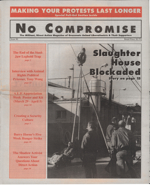
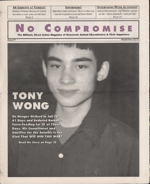
…
-
Periodicals
Holocaust #4
05.24.11 | PermalinkHolocaust #4 (1994, Syracuse, NY USA.)
Holocaust was published and edited by Kris Qua, who, during his time as a high school student in upstate New York, founded the first chapter of the Animal Defense League. His magazine was as influential as his group, and in the Syracuse area it helped spark the participation of a number of young activists. Its politics were not perfect, and I am sure that many of our readers will be disappointed with the anti-abortion rhetoric at this end of this issue written by former Hardline adherent Dave Agranoff. Most issues contained similar articles. Still, Holocaust was an important publication from a key region during an era of growth and change in the movement.
It is also exceedingly rare! We post this issue in the hopes that our readers will check their collections for the rest of the series as we would very much like to have a complete set. Contact us at conflictgypsy ((at)) gmail ((dot)) com if you can help us finish our collection of this historically significant east coast zine.
…
-
Periodicals
The Militant Vegan
03.14.11 | PermalinkThe Militant Vegan 1-8 (January 1993 – March 1995. USA.)
Militant Vegan was an anonymously produced zine that ran for 8 issues between 1993 and 1995. The final issue was never printed by the team who produced the magazine, instead the files were distributed online. Due to the poor quality of modems and low usage of the internet at the time the issue was mostly lost to history. Other things contributed to the mag’s obscurity as well. For example- there was no address to order the magazine from. Instead, originals were distributed to some animal rights groups and it was requested that they make copies, and that the readers of those copies make further copies to distribute to activists. Since the publication already relied on much cutting and pasting this method of circulation resulted in heavy generation loss of images, and obtaining readable copies wasn’t always easy. Even activists who were heavily involved in the movement at that time never saw every issue. Conflict Gypsy was luckily able to track down a complete set, including the rare eighth and final dispatch.
Printed in starkly contrasted black and white, and dressed in over-the-top, macho imagery, Militant Vegan’s primary purpose was to publicize actions and news ignored by mainstream movement publications. Otherwise, the philosophy of the magazine was vague. It was pleasant to read a brief denunciation of the sexism and homophobia advocated by the “Hardline movement” in MV’s early issues, but elsewhere there was less clarity. For example, ALF guidelines prohibiting violence appeared alongside statements celebrating the poisoning of animal products left on store shelves. (These actions turned out to be hoaxes, and no one was actually poisoned.) Frequent reminders that the publishers didn’t wish to encourage illegal activity appeared alongside instructions on how to do exactly that. And despite the angry condemnation of speciesism, cops are still referred to as pigs in a page reprinted from Defiance #1. The rhetoric could be ugly and was generally unlikely to convince people that direct action was an ethical tactic that provided the movement a way forward.
Despite all of this there was nothing quite like Militant Vegan at the time that it was published, and it documented the rise of a new era of grassroots activism in the United States prior to the publication of No Compromise. For the lucky few who could obtain copies, MV brought news of groups like Student Environmental Action League, Coalition to Abolish the Fur Trade, and Animal Defense League into their homes when glossy magazines like Animal’s Agenda did not. After a sharp dip in the number of underground actions in the earlier part of the 90s, Militant Vegan was a good source of information on the new trend towards smaller scale economic sabotage. Occasionally a well written original article appeared, and seeing press clippings from former radical (and current HSUS honcho) JP Goodwin’s convictions for sabotage remains amusing. Finally, the letters from prisoners were at times inspiring, and the coverage of Rod Coronado’s case from arrest to conviction is essential reading.
In total, Militant Vegan was a product of its time, written by amateurs who saw a niche and decided to fill it. It remains one of the only insider perspectives from that period of underground and radical grassroots animal liberation activism.








…
-
One-off publications
Counter Friction
03.14.11 | PermalinkCounter Friction #1 (1998, Bloomington, IN. USA)
By the late 90s, it was becoming apparent that despite the commitment and energy of the militant grassroots, little was being accomplished for non-humans. A lack of focus on a single target, and minimal regional or national coordination had left the movement with few gains, frustrated organizers, and many participants drifting away. One early attempt at correcting the problem was a drive by members of the Animal Defense Leagues and CAFT to unify their efforts by publishing a joint newsletter called Counter Friction.
Counter Friction was well intentioned, but upon its release it had little impact. First and foremost, if anything the magazine served to highlight the overly diverse targets and lack of framework within the groups. Some groups were focused on fur, some on fundraising, some on vegan outreach, and despite JP Goodwin’s call for unified action, everywhere else in the magazine there was a sense of not knowing what to do next. Second, the publication came out during a time period of intense turmoil and lower participation caused by the conflict between supporters of Freeman Wicklund’s ill fated strategic non-violence plan, and more traditional grassroots militants who supported underground activity. Third, the articles were written by organizers who might be proficient at putting together a protest but miserable at composing a few paragraphs about it. With few exceptions the content was poorly written. Finally, there was an unintentional conflict in the mission for the newsletter: On the one hand it was meant to start creating a centralized clearinghouse for CAFT and ADL, but the other purpose was to drive people towards local chapters. Subscribers were told to contact local groups for subscriptions, to send submissions to the central group, to contact CAFT for merchandise, to contact ADL for literature, and in the end confusion abounded.
By the time managing editor Rachael Astachan requested that chapters send in articles and updates for the second issue the steam had run out for many of the ADL’s and CAFT affiliates. In a frustrated e-mail to the ADL group e-mail list she left the project, and it was never revived.
…
-
Periodicals
Dressed In Black
03.14.11 | PermalinkDressed in Black 1-3 (1994-1995. Syracuse, NY USA.)
Dressed in Black was a short lived zine produced and distributed by members of the Syracuse Animal Defense League. It ran for 3 issues in the span of just over a year and then died out right around the same time as Syracuse’s other animal liberation publication, Holocaust. DiB’s infancy followed the pattern set by Militant Vegan in that it relied heavily on articles reprinted from other sources, but that strangely ended up being its primary strength.
To be aware of magazines such as Frontlines, Out of the Cages, or Liberator you already had to be a part of the movement. To obtain a copy in those days you had to mail a request along with hidden cash and sometimes even a return envelope. People who were not already committed to the cause were unlikely to do that, but Dressed in Black, at least in its first issue, acted as an aggregator for articles from those publications and got into the hands of non-activists by being distributed at hardcore shows.
Syracuse was one of many cities in the US that experienced a surge of youth led AR activism in the early 90s, but unlike Memphis or Minneapolis, Syracuse had a special ingredient that helped spread awareness of grassroots groups and local zines – the band Earth Crisis. After releasing their All Out War EP in 1992, the band’s popularity boomed. They often had chapters of the Animal Defense League tabling at their shows, and as Conflict Gypsy sought out copies of Dressed in Black many people told us that their introduction to the zine came at Earth Crisis shows in various places across the country.
By the third issue, Dressed in Black contained original writings and cleaned up its layout. It was surprisingly non-dogmatic for its era, and depicted ADL activists “going naked,” contained information from national organizations, and managed to avoid the pseudo-religious insanity of “Hardline.” Due to its wide circulation, DiB eventually became one of the zines that others copied articles out of, an interesting full circle for this small publication that died before reaching maturity.


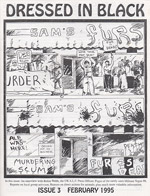
…
-
Periodicals
Do Not Consider Yourself Free
03.14.11 | PermalinkDo Not Consider Yourself Free # 1-3 (1997 – 1998. New York, NY. USA.)
Do Not Consider Yourself Free was the official newsletter of the New York City Animal Defense League chapter. Contributors included many prominent 90s activists, such as Sarahjane Blum, Patrick Kwan, Kim Berardi, Ryan Shapiro, Lance Morosini, Brian Smith, Melanie Bartlett, Darius Fulmer, Justin Taylor, Christine Matyasovsky, and Lauren Gazzola. The publication primarily covered the ADL’s spectacularly planned acts of civil disobedience against the fur trade and many arrests of its members, but also included interviews and original articles. It remains one of the most well known and fondly remembered newsletters of its era.
Conflict Gypsy is proud to present the complete set here along with this new introduction by Ryan Shapiro.
“The late 1990s was a different world, and the NYC Animal Defense League rocked that world. Working closely with the Long Island, New Jersey, Connecticut, and Syracuse chapters of the ADL, as well as with the NYU animal rights organization SEAL, the NYC-based Wetlands Animal Rights Action Team, and DC-based Compassion Over Killing, NYC ADL warred against animal exploitation and abuse in New York City.
NYC ADL sought to combine the aggressive militancy that characterized the grassroots animal rights movement of the late 1990s with a parallel focus on strategic and tactical planning. Our goal was to be both radical and smart. Efficacy was our watchword. As such, NYC ADL members could be found in camos while recruiting at Earth Crisis shows and in suits and dresses while occupying the President’s office at NYU (even if we still had Firestorm playing on the President’s stereo).
We placed particular emphasis on our civil disobedience actions. In the heady days before 9-11 and the Animal Enterprise Terrorism Act, NYC ADL organized seemingly ceaseless opportunities to challenge animal exploitation by locking ourselves to things. Through boldness of vision, obsessive attention to detail, and the courage of our membership, NYC ADL sought to perfect the art of the urban blockade. Whether it was learning the science of concrete solidification or busting out the algebra to determine the optimal participant distribution for a lockdown, NYC ADL devoted ourselves to coordinating spectacular acts of civil disobedience that served as models for other groups around the country. Among our proudest accomplishments was to repeatedly shut down the world’s largest store, Macy’s Herald Square, in protest of Macy’s continued sale of fur.
Due primarily to the departure from NYC of many of ADL’s leading coordinators, the group began to falter in 2000. Even in its demise, however, NYC ADL served as a feeder for some of the most significant grassroots animal rights campaigns of the new millennium. After leaving NY, veterans of NYC ADL served as key participants in, amongst others, the SHAC campaign, the campaign to shut down Makah whaling, and the campaign to expose factory farming through “open rescue.”
Over a decade later, NYC ADL seems both like yesterday and a lifetime ago. In either form of memory, however, I remain deeply humbled to have served alongside activists so passionate and dedicated. It is truly one of the great honors of my life to have been a part of NYC ADL. Thank you to everyone who fought for animals alongside us, and to everyone who continues the fight today. NYC ADL is gone, but the message lives on: As long as others are held captive, do not consider yourself free.”

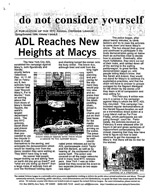

…
